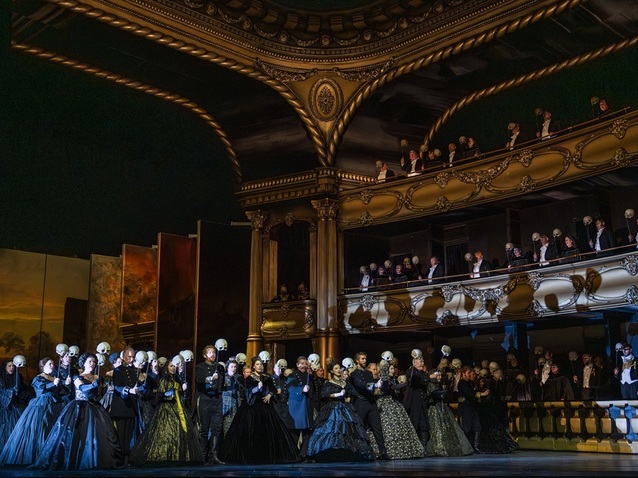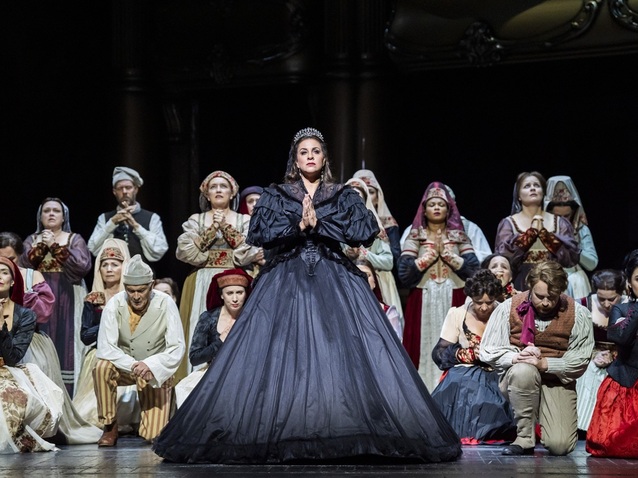 © 2025 Tristram Kenton
© 2025 Tristram Kenton
Giuseppe Verdi’s The Sicilian Vespers of 1855, set to a French libretto by Eugène Scribe and Charles Duveyrier from their 1838 work Le duc d’Albe, tells of the French occupation of Sicily in the thirteenth century. Prior to the opera’s opening the Sicilian patriot Jean Procida was exiled and the French conqueror Guy de Montfort, who became the island’s governor, violated a Sicilian woman who subsequently had a son called Henri. At times the Sicilians are a little too ready to accept their subservient position, but three individuals are determined to set the island free, and frequently succeed in whipping up the crowd. The first is Procida, who during Act II returns from exile, the second is Henri, who at the start has no idea that Montfort is actually his father, and the third is Hélène, who seeks revenge for the governor having killed her brother, Duke Frédéric of Austria.
Henri falls in love with Hélène, but the fact that Montfort is his father sees everyone face predicaments as their private feelings for individuals conflict with their public loyalty towards their people. Although Henri is an enemy of the French who would normally be taken from his prison cell to be executed, Montfort pardons and releases him because he is his son. When Montfort subsequently tells him who he is, the horrified Henri says this makes no difference to his loyalty to the Sicilians and refuses to call him father. Nevertheless, it still leads him to warn Montfort to flee when he knows Procida and Hélène are planning to kill him. This and Henri’s subsequent action help Montfort to foil their plot, leading Procida and Hélène to face execution and to Henri being seen as a traitor.
When Montfort sees Henri’s willingness to die alongside Hélène, he realises their love for each other, and when (under coercion) Henri accepts Montfort as his father, the governor pardons them and supports their marriage. It looks for a while as if this will achieve a peace between the French and Sicilians, but Procida, who was also pardoned, still plans to defeat the French with the ringing of the wedding bells being the signal for his supporters to start their attack. When Hélène discovers this, she fears for Henri’s life and so says she cannot marry him in an attempt to ensure the bells are never rung. This leaves him distraught, as she cannot tell him her real reasons as she still feels loyalty towards her people. In the end, the bells are rung, having been instigated by both Procida, who wants the attack to start, and Montfort, who cannot understand why the pair would not want to be married, and the curtain falls on the Sicilians advancing.

Joyce El-Khoury as Hélène In The Sicilian Vespers © 2025 Tristram Kenton
This is the second revival at the Royal Ballet and Opera of Stefan Herheim’s 2013 staging, which represents a co-production with the Royal Danish Opera, Copenhagen, and it features a notably strong cast. The four main principals all assert their voices to tremendous effect, while interacting with each other in ways that bring out the dilemmas they face to the full. As Henri, Valentyn Dytiuk, who replaced a previously advertised SeokJong Baek, reveals an incredibly expansive tenor that is frequently overwhelming and never shows any signs of flagging. As Montfort, Quinn Kelsey displays his immensely firm baritone to excellent effect, and the interaction between the two is superb. In the scene in which Henri discovers Montfort is his father the two at one point join hands in a way that might imply triumph, but, because Henri will not accept him, Montfort uses the grip he has to throw Henri to the ground.
Joyce El-Khoury, who also stepped in at short notice to replace Marina Rebeka as Hélène, reveals a soprano that is capable of being extremely impassioned and full blooded, but also exceptionally fragile when she is both mortified and confused by Henri’s apparent betrayal (Sara Cortolezzis plays Hélène on 3 October). The character of Procida does not face dilemmas in quite the same way as the others as for him there is nothing to complicate his overriding aim to free Sicily. Ildebrando D'Arcangelo captures Procida’s single-mindedness in every way as he asserts his rich, dark baritone. In the pit, conductor Speranza Scappucci achieves a welcome balance between smoothness, focus and exuberance.
Verdi wrote The Sicilian Vespers when at the height of his powers, having enjoyed successes over the preceding years with Rigoletto, Il trovatore and La traviata. This encouraged him to compose a piece that in every way would fulfil the expectations of what a grand opéra, the style that was all the rage in Paris at the time, should be. Herheim’s production, which is revived now as in 2017 by Dan Dooner, instils the notion of grand opéra into the very fabric of the staging. The setting is moved forward to 1855, when the opera premiered and the genre reigned supreme. In Philipp Fürhofer’s inspired set, the action takes place largely in an opera house, which seems similar to the Palais Garnier or Palermo’s Teatro Massimo, and a second mirrored room that looks like a rehearsal space. Theatres can be a place of escape for us all, and so it seems appropriate to position the French soldiers inside one when they sing of how residing in Sicily provides them with relief from their hard lives back home.
The theatre and rehearsal room could be metaphors for the countries, although it is not the case that one of the two spaces always represents France and the other Sicily. They move around in any case, and a mural on the wall suggests both France, as it is in the style of Nicolas Poussin, and Sicily, since the volcano and ruins it depicts could be Mount Etna and Agrigento.

Quinn Kelsey as Guy de Montfort in The Sicilian Vespers © 2025 Tristram Kenton
During the Overture we see Procida as a dancing master teaching ballerinas. Then the French burst in, injure Procida and attack the women. Montfort rapes Henri’s mother but only after forcing everyone to dance and choosing the only woman not to collapse from exhaustion, as if he is deliberately selecting the strongest to be his son’s mother.
The dancers, who are choreographed by André de Jong, appear regularly throughout the opera, which ties in with the fact that dancing was an integral part of grand opéra. However, when we see the ballerinas who Montfort has conquered dressed in black, either appearing pregnant or with babies strapped around them, it seems as if we are witnessing a struggle between Procida and Montfort over whose tune Sicily will dance to. This is not to suggest that the two are as bad as each other because Montfort is an invading, violent rapist. Nevertheless, when we see Procida training up the dancers it is clear that he wishes to mould them in his own image of how an independent Sicily should be, and it is his rigidity on what is to be accepted as Sicilian that propels the violence when peace is a real option. At one point he is actually seen training the ordinary citizens to rebel as if they are ballerinas, which injects a touch of humour into the proceedings as we see them all working out at the bar. It also marks the room out as the place where the Sicilians rehearse for the liberation of their country, and acts as a counterpoint to those moments when the French soldiers sit in the opera house enjoying the ‘spectacle’ of Sicily.
Although the staging signifies a great deal, it is equally important that it is visually stunning in its own right. In fact, when at the end Anders Poll’s lighting designs illuminate the entire auditorium, it is impossible not to feel a little overawed by the effect, even though we are aware that what is to follow will be far from beautiful.
By Sam Smith
The Sicilian Vespers | 19 September - 6 October 2025 | Royal Ballet and Opera, Covent Garden
the 21 of September, 2025 | Print
Comments